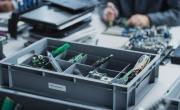Repic research finds minority of consumers buy used electricals
This first report examines what influences consumers to purchase second-hand and refurbished electricals and comes as part of the producer compliance scheme’s launch of its new website and the introduction of a comprehensive online resource section.
 The newly launched REPIC website will house a dynamic hub - Making a Difference - which has been designed to be a source of knowledge for anyone involved with WEEE - openly sharing the latest updates, research papers and invaluable insight from the scheme’s collaborative partnerships with organisations across the UK, Europe and beyond.
The newly launched REPIC website will house a dynamic hub - Making a Difference - which has been designed to be a source of knowledge for anyone involved with WEEE - openly sharing the latest updates, research papers and invaluable insight from the scheme’s collaborative partnerships with organisations across the UK, Europe and beyond.
Louise Grantham, Chief Executive at REPIC, commented: “Our aim is to foster a deeper understanding and awareness of the WEEE sector, specifically exploring the challenges and opportunities arising. The new dynamic platform provides organisations and individuals with the information they need to make informed decisions and contribute to a more sustainable future. From cutting-edge research on the circular economy to real-life updates on industry projects, our website aims to be the go-to destination for staying at the forefront of waste electrical management.”
Used electricals: Consumer insights
Key findings within REPIC’s Consumer Insight research on used and refurbished electricals include:
- An overwhelming four-out-of-five consumers opted to purchase brand-new electrical products, with only 4% choosing used or refurbished alternatives. The report identifies habit as a significant driver for these choices, with consumers associating new items with heightened reliability and safety.
- For those embracing the used market, the primary motivation emerges as cost-effectiveness, especially when confidence in the product's condition is assured. Notably, a minority (eight per cent) adopt a conscious lifestyle choice, emphasising environmental concerns and indicating a potential avenue for more sustainable consumer behaviour.
- The mobile phone market stands out as a success story in the used appliance market, offering valuable insights for potential replication in other product categories.
- Two-thirds of household’s express openness to purchasing used electricals, though preferences vary across product types. Tech products are more readily accepted, whereas grooming items are largely avoided.
Summarising the findings in this first report of the series, Louise Grantham, concluded: “Our research reveals that there is opportunity to increase the amount of reuse taking place – as across multiple categories, a notable proportion of households show a willingness to buy used electricals. This behaviour is particularly pronounced for larger appliances such as washers/dryers (24 per cent), small-medium TVs (27 per cent), and handheld vacuum cleaners (20 per cent). It is encouraging to see a substantial proportion of consumers are open to extending the life cycle of these items through reusing appliances, contributing to a more sustainable and circular economy. This, of course, has to be balanced with ensuring consumers have confidence in the products they are acquiring, being safe to use and not extending them beyond their optimal lifespan causing higher ongoing running costs. These were both important factors to consumers when considering whether to acquire a used or refurbished appliance.
“Similarly, the data reveals a positive attitude towards purchasing refurbished items. For categories like large household appliances (31 per cent) and large TVs (31 per cent), a significant percentage of households are open to considering refurbished options. This suggests a growing awareness and acceptance of reconditioned products, aligning with efforts to promote resource efficiency.”
Challenges and opportunities
With the report highlighting a growing receptiveness among households to adopt sustainable behaviours in their consumption patterns, REPIC has been supporting a growing number of its scheme members to embrace practices that contribute further to this environmentally conscious approach to appliance consumption. From supporting their WEEE take back operations, assisting with the development of strategies to improve resource efficiency through the entire product lifecycle or taking part in market leading research to drive impactful change; maximising our use of the valuable resources electrical products contain is essential in our journey towards delivering circular business models and net zero






